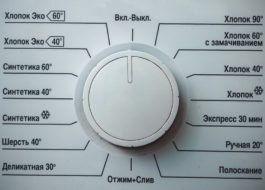Beko washing machine takes a long time to wash
 Depending on the selected program, washing can last from 15-20 minutes to three hours. Washing machines with a display display the time remaining until the job is completed on a display. When the device does not have a screen, you need to monitor the cycle duration yourself. What should I do if my Beko washing machine takes a very long time to wash? For example, a mode has been started for 45 minutes, but the equipment has been running for an hour and a half? Let's figure out what could be causing the failure and where to start diagnosing it.
Depending on the selected program, washing can last from 15-20 minutes to three hours. Washing machines with a display display the time remaining until the job is completed on a display. When the device does not have a screen, you need to monitor the cycle duration yourself. What should I do if my Beko washing machine takes a very long time to wash? For example, a mode has been started for 45 minutes, but the equipment has been running for an hour and a half? Let's figure out what could be causing the failure and where to start diagnosing it.
Why did this happen?
The machine may continue to wash for longer than expected due to various factors. It is quite difficult to immediately determine the exact cause of a breakdown; you need to observe the operation of the equipment and identify the “symptoms” of the malfunction. The failure is usually explained by:
- drum overload. If you violate the manufacturer's restrictions and put too many items into the machine, the machine will spend extra time distributing the clothes inside the drum. This is why the cycle may lengthen by several minutes;
- problems with getting water into the system. If the washer's inlet filter or its inlet hose is clogged, the solenoid valve is defective, or there is low pressure in the pipes, you can expect the cycle to prolong. The machine will take a very long time to fill the tank at all stages of the wash, this will significantly increase the program execution time;
- prolonged drain. The “brain” of the washing machine takes about a couple of minutes to drain the water from the tank. Liquid is removed from the system several times, at least during the main wash, rinse and spin cycle.If you add 5-7 additional minutes to each “drain”, the total cycle time will increase significantly. The reason for this may be a clogged drain hose, garbage filter, or drain pump;
- failure of the heating element or thermostat. With such a malfunction, the water takes much longer than usual to heat up to the required temperature, so the cycle is delayed. It is likely that scale has formed on the tubular heater, as a result of which its performance has decreased. Another option is that the thermostat is defective, the sensor cannot record the correct water temperature, the “brain” does not start the wash;
- failure of the control module. In this case, the washing machine “freezes” while the program is running, then starts working again, and so on in a circle.
In general, washing times can increase for various reasons. You will need step-by-step diagnostics of the washing machine. What to do first and what to check at the end, we will analyze further.
No water coming in, too many things
If you put too much laundry in the Beko washing machine, more than what is allowed in the instructions, it will become more difficult for the machine to distribute the items over the surface of the drum. It will also not be easy for the equipment to “spin up” to the required speed. The program will start running, but it will take longer than usual. A batch of clothes loaded with a lump can also slow down the cycle.
It is important not to overload the Beko washing machine, carefully place the laundry in the drum, distributing the items evenly over the surface.
Another factor that results in longer wash cycles is the slow intake of water into the system. This situation can occur due to:
- low pressure in the water supply;
- not fully open inlet valve;
- clogged incoming mesh filter;
- intake valve defect;
- the inlet hose is clogged.
If the whole point is insufficient pressure, you need to wait until the water in the pipes flows with the same force. The blockage can be removed by cleaning; the intake valve will have to be replaced. Diagnosis should begin from simple to complex. First, check the water pressure, then inspect the shut-off valve, then inspect the inlet hose. Then you can go “deeper” - get to the mesh filter and solenoid valve.
Too much water, no drain
The machine may take longer to wash than usual due to slow drainage. Therefore, noting that the work “slows down” precisely at the stage of removing water from the tank, it is necessary to inspect the elements of the drain system. The reason may be:
- Drain filter clogged. It is located at the front, at the bottom of the washer. Be sure to unscrew the element, wash it, clean the installation site and return the plug to its place;
- impeller failure. By unscrewing the garbage filter and shining a flashlight into the hole, you can see its blades. Roll them with a long stick. If the rotation is broken, the part will have to be replaced;
- clogged drain pipe. This is a tube that runs from the washer tank to the pump. The element will need to be cleaned;
- drain hose defect. Through it, the machine discharges water into the sewer. Often blockages form inside the cavity. Perhaps cleaning the hose will help. By the way, check that the drain hose is not pinched.

It’s not just the long drain that makes adjustments to the operating life of the Beko washing machine. The reason may be too fast, uncontrolled by the intellect, removal of water from the tank. This may be a consequence:
- incorrect connection of the unit. If the drain hose is simply thrown onto the floor, then the water will flow out of the tank by gravity.The “brain” will give the command to draw in liquid, and it will immediately flow back into the sewer. The cycle can drag on indefinitely. Check that the drainage hose is connected according to all rules, at a level of 50-60 cm from the floor;
- incorrect operation of the pressure switch. The sensor signals to the main module that the tank is full and it is possible to proceed to the next stage of washing. If the element is faulty, it can tell the “brain” that there is too much water. The liquid will drain, then the tank will fill again, and so on in a vicious circle. Replacing the pressure switch will solve the problem.
The washing time increases with slow drainage or, conversely, uncontrolled removal of water from the machine.
What to do in this case? You can repair the machine yourself. Even a beginner can handle cleaning the elements of the drain system. Replacing the pressure switch is also easy, the main thing is to follow the instructions.
The water does not heat up well or does not heat up
The washing ends on time when all components of the Beko washing machine are functioning properly. The cycle may take longer due to a breakdown of the heating element or temperature sensor. If it is not possible to “bring” the water to the required degree, the machine operates longer than intended.
Often the heating element cannot heat the water in the allotted time due to a thick layer of limescale. Hard water contains various impurities that settle on the tubular heater. Thus, the element becomes covered with scale, as a result of which its heat transfer properties are disrupted. The water heats up very slowly. There is a way out - you can try to clean the heating element or install a new one. If the part is “burned out”, then the Beko washing machine will not even start to rotate the drum; only replacing the heater will help.
A slowdown in the cycle can also occur if the thermostat breaks down.In such a situation, the sensor gives the “brain” incorrect signals about the temperature of the water in the tank. Intelligence waits for the thermostat to transmit information about the “right” degree. The “waiting” process may take a couple of hours. Replacing the thermistor can solve the problem.
Modern Beko washing machines, when the heating element or thermostat fails, notify you of the breakdown by displaying the corresponding error code on the control panel.
You can carry out the diagnosis yourself. Having pulled out the heating element, see if there is scale on its surface. If there is no plaque, check the part with a multimeter. The heater or temperature sensor cannot be repaired; the elements will have to be completely replaced.
Electronic board
The worst thing is if the cycle is slowed down due to problems with the main module. Damage to the control board is a serious breakdown, for which it is better to contact a professional to fix it. If the controller malfunctions, the Beko washing machine will work, periodically freezing until the user stops the cycle.
Troubleshooting is not easy. In some situations, reflashing washing equipment can help, in others, replacing triacs or soldering tracks on the control board, in others, reinstalling the module. In order not to harm the equipment, you should not delve into electronics yourself without sufficient skills and experience. You will need serious diagnostics of the automatic machine, which will not be possible without special tools and devices. In this case, it is better to entrust the repair to a specialist.
Interesting:
2 reader comments
Add a comment Cancel reply
Categories
Washing machine repair


For buyers

For users

Dishwasher

















I have a Beko automatic washing machine. I washed it and it doesn’t finish. What to do?
Washing machine AUTOMATIC VEKO. When set for 4 min. washing, washes for 2.5 hours.